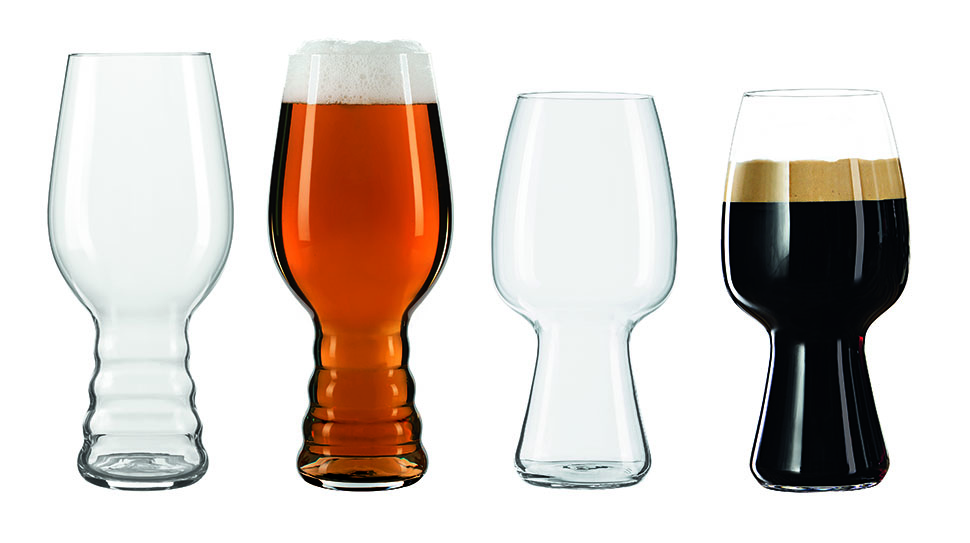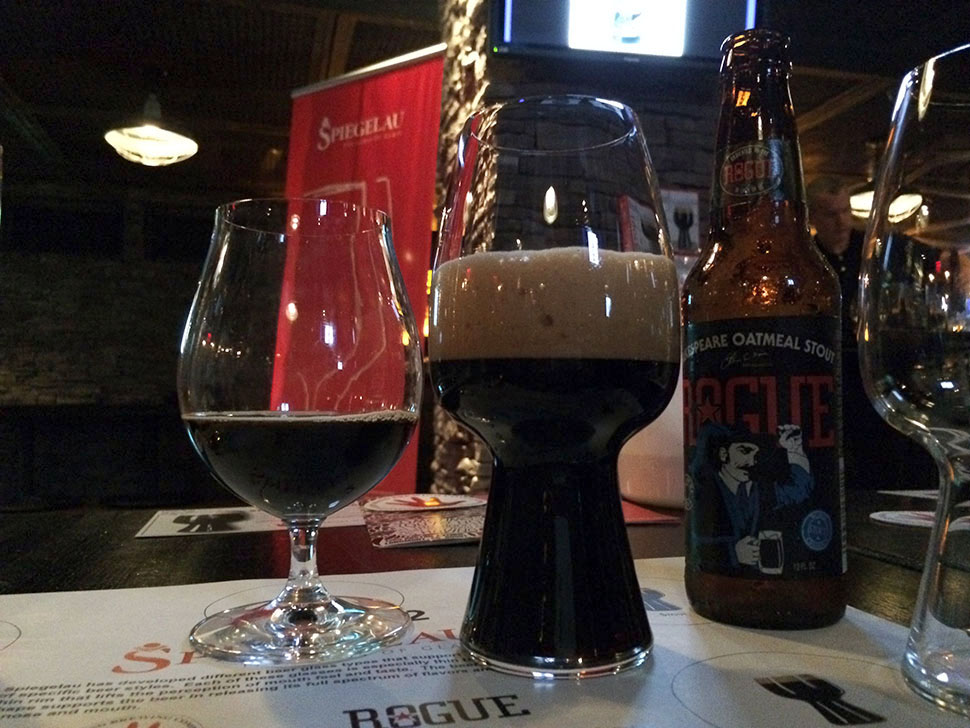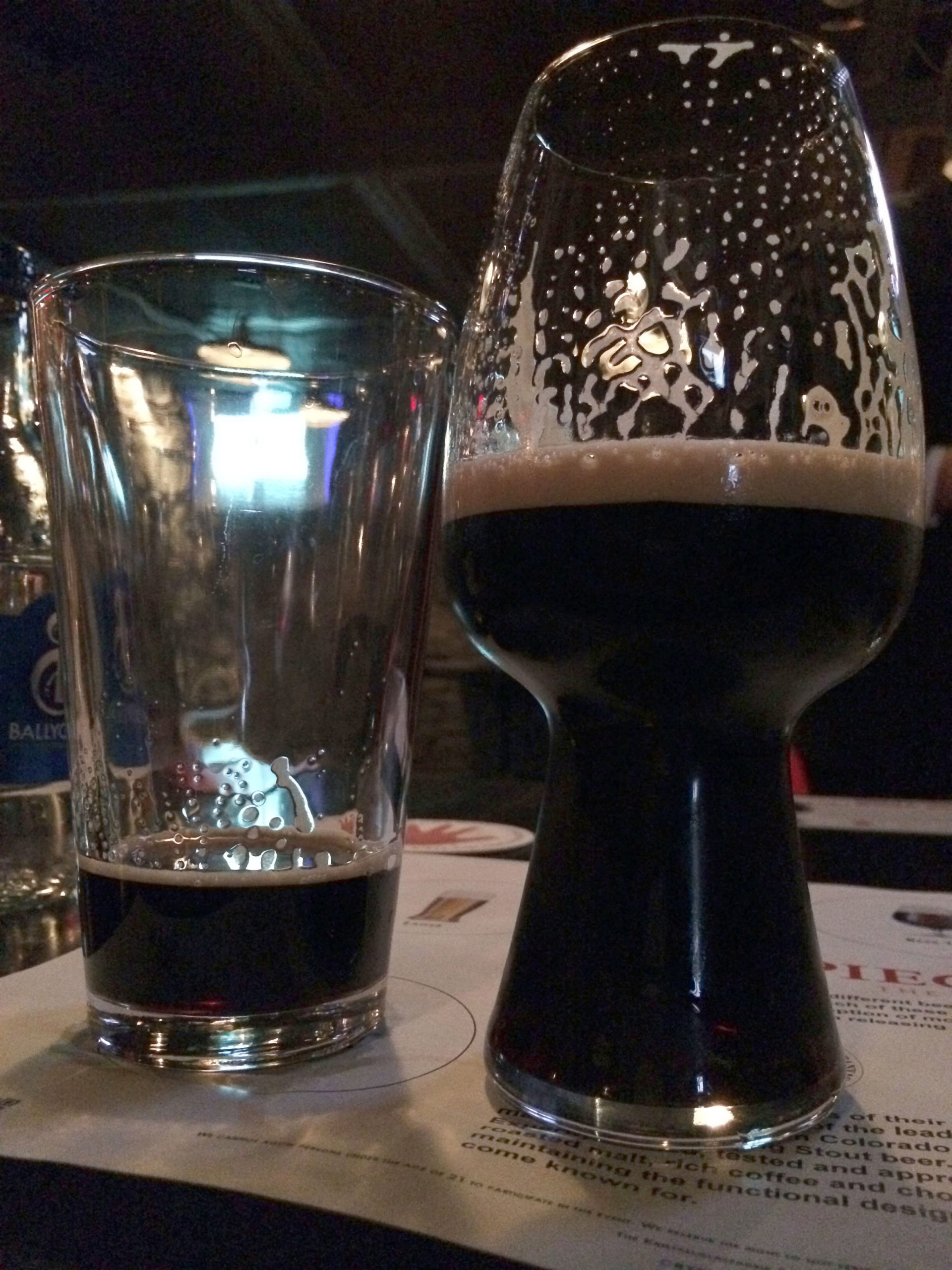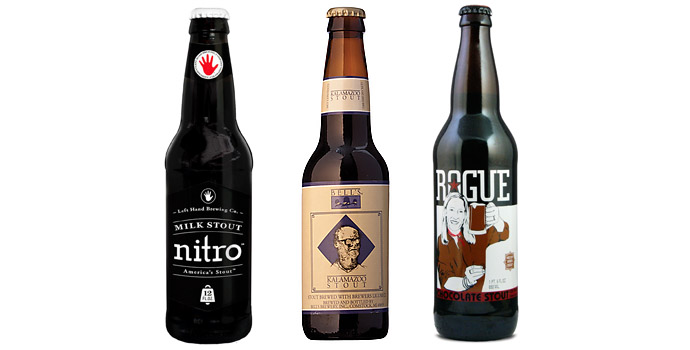It’s just not fair: every single grape varietal and wine style, including some that no one has ever even heard of (Kalterer See Auslese, anyone?), has its own specially designed glass. Even Coca-Cola now has one. But, for beer, your standard mouth-delivery vehicle is the same, whether you’re drinking the wateriest Bud Lite or a limited edition, quadruple-hopped, barrel-aged brew: either a shaker pint glass (so-called because it was designed for making martinis), or, if you’re super classy, the bottle itself.
But surely that’s the point? I mean, beer doesn’t need that kind of frou-frou oenophile stemware to express its true deliciousness, right?
Wrong. The world’s first stout-specific beer glass made its debut this week, and Gizmodo gave it a try. It’s a serious upgrade. Here’s what you need to know about our brave new world of beer-style specific glassware.
It’s time for Happy Hour, Gizmodo’s weekly booze column. A cocktail shaker full of innovation, science and alcohol. It’s time to optimise your beer drinking experience with the right glass for the job.
What Is It?
The world’s first stout-specific beer glass is a collaboration between Left Hand Brewing, of Longmont, Colorado, Rogue Ales of Newport, Oregon, and Spiegelau, a 500-year-old German glass company that became part of the Riedel empire in 2004.
Not content with creating a glass for each of the world’s more than 100 grape varieties, Riedel/Spiegelau first experimented with a beer-style specific glass last year, when they worked with Dogfish Head and Sierra Nevada to make an IPA glass. With a rippled base and slightly rounded bulb top, that glass promised to showcase the hoppy style’s big aroma and maintain its head.

A good stout, on the other hand, is a deep, dark beer, with lots of roasted malts, a smooth, creamy mouthfeel, and coffee and chocolate flavours. The Spiegelau/Left Hand/Rogue stout glass was unveiled in New York City on Wednesday night, and, on first glance, it looked remarkably similar to its IPA big brother. No ripples in the base, a little shorter, and with more of a shelf in the bulb, but definitely related.
“It’s like comparing a Ferrari and a Lamborghini,” Rogue’s Brett Joyce told me. “They both go fast, but that’s it. I use the IPA glass at home and I love it, but they’re completely different.”
It took 9 months to arrive at the final design — longer than Spiegelau had hoped. Following the success of the IPA glass, which sold much better than expected, Spiegelau’s Matt Rutkowksi approached Eric Wallace, co-founder of Left Hand, and Brett Joyce, president of Rogue, two breweries that are defined by their multi-award-winning stouts.
After an initial group workshop in which the brewing teams from both Left Hand and Rogue tasted a range of stouts (not just their own) in 12 different existing Spiegelau glasses, to create a matrix that recorded their impressions of what worked and what didn’t, the Spiegelau delegation went back to Germany and made some prototypes.

The first workshop, at which the brewing teams ranked twelve different existing Spiegelau shapes and forms on a matrix.
But, at the second workshop, the two breweries were deadlocked: Left Hand’s brewmaster, Joe Schiraldi, favoured a design that really focused the aroma, while Rogue’s John Maier, a man whose beard yeast has generated its own beer, preferred a shape that perfected the flow of beer onto the tongue.

The final workshop, where the brewing teams worked separately to rank six different but nearly identical prototypes.
Speigelau went away again, and came back with six new prototypes. “At this point,” said Joyce, “we were splitting hairs, but it was important to get it right.” Tasting independently, both breweries chose the same glass: Prototype C. With a sigh of relief, Spiegelau fired up a lake of molten glass, and put the world’s first stout-specific glass into production.
The Side-by-Side Taste Test
There are rules for a glassware tasting, which basically boil down to the mantra: “See It, Smell It, Taste It.” You can easily follow them at home to figure out which glasses different beers taste better in, from within the range of glassware you already own.

A shaker pint, a Spiegelau lager glass, a Spiegelau beer tulip, and two stout-specific glasses, ready for testing. Photograph by Mark Von Holden.

Rogue’s Shakespeare Oatmeal Stout in a beer tulip and a stout-specific glass. Photograph by Nicola Twilley.
We started by pouring Rogue’s Shakespeare Oatmeal Stout in a shaker pint, a Spiegelau beer tulip, and the stout-specific glass. The head on the beer tulip and stout glass was noticeably frothier, which helps boost the aroma, too. On pure aesthetics alone, the stout glass was the clear winner: the shelf at the bottom of the bulb created a gorgeous internal waterfall, with lighter-coloured bubbles falling downwards into the black stout like sand in a timer.
Then we stuck our noses into each in turn, taking a deep breath. From the pint glass, the aroma was thin and kind of unpleasant — it reminded me why I’m not a stout drinker. In the tulip, the smell was nice: the traditional stout roastiness. The stout glass made the aroma much more intense — I could smell it clearly with my nose 3 inches away — and also more complex, with some bready, toasty notes added to the roast coffee.
Finally, we took a drink from each. This is where the difference really kicked in, for me. From the pint glass, the beer was flat and bitter, with a dry tannic finish. I really didn’t like it. From the tulip, it felt a little better in my mouth, but was still very bitter at the end.
The difference that the stout glass made was so ridiculous, I actually laughed out loud. It was super creamy and smooth, like a really good mocha. I couldn’t stop drinking it.
It honestly tasted as though I had tried two different beers.

Left Hand’s Nitro Milk Stout in a shaker pint and stout-specific glass. Check out the lacing on the stout-specific glass — beer nerds love that, both because it looks pretty and because it’s a sign that the beer is retaining its carbon dioxide and foamy, creamy head. Photograph by Nicola Twilley.
By the end of the tasting, as I sat with Rogue’s Chocolate Stout in a stout-specific glass in one hand and Left Hand’s Nitro Milk Stout in a stout-specific glass in the other, feeling as though I was alternating between the world’s creamiest vanilla milkshake and a dive into Willy Wonka’s chocolate river, I was fully converted.
So, Is It Worth It?
If you’re into craft beer, it really is. I wasn’t actually a stout fan when I went into the tasting — they have always struck me as too bitter and heavy. I was also sceptical that the stout-specific glass would be that much better than any other decent glass, despite the science behind it.
The stout-specific glass just improved everything that was already great about the beers. The internal shelf and columnar base acted as a bubble recharger, keeping the carbonation level steady and the head frothy. The bulb shape concentrated and focused the aroma toward your nose — Eric Wallace called it “an olfactory cannon.” The thinner glass kept the beer colder longer (counter-intuitive but that’s thermodynamics for you), and the shelf shape regulated the flow of beer into your mouth so you could savour each mouthful, rather than simply swallow.
Added all together, it made the difference between happily dumping my shaker pints after tasting them, and lingering in a hedonistic trance with a glass of stout in each hand long after the tasting was over.
Brett Joyce, who was too embarrassed to admit what kind of glass he had previously been using, compared drinking his own Shakespeare Oatmeal Stout out of the stout glass to flying First Class for the first time — you never, ever want to go back to coach.
“It tasted pretty great before,” he said, noting that upon its debut, the Shakespeare had scored 99 points out of 100, the highest score out of all 309 beers in the 1994 World Beer Championships. “Out of this glass, though,” he added, “we’d need to go to 110 on the scoring!”
Like everything in life, there are some downsides. The narrow base section makes them a pain to clean if you don’t have a dishwasher, and, although they are not as fragile as the fancy Riedel stemware, they are definitely not as sturdy as a regular shaker pint glass.
Finally, the glasses are not cheap. A box of two is $24.90 on the Spiegelau site, and will soon be available at Crate & Barrel and Bloomingdale’s at that price point too. You can also buy the same glass, decorated with a logo, for less at the breweries’ own websites: Left Hand is selling them singly for $9 each, and Rogue is offering two for $US18.
My take is that, if you’re already spending what it costs to drink these more expensive craft stouts, the glass price is not such a stretch, and, I think, well worth it for the difference it makes.
But I Can’t Afford a Fancy Glass!
Don’t worry, you can still do a few free and easy things to optimise your craft beer experience, and you should.

Brett Joyce (left) of Rogue and Eric Wallace of Left Hand (with the mike) led us through the tasting. Photograph by Mark Von Holden.
Use A Glass
The first is to just use a glass — any glass. When I asked Eric Wallace of Left Hand if it was OK to drink out of the bottle, his reply was, “Sure, if you want to lose 80 per cent of the flavour.” I’m so lazy, I’ll do anything to avoid adding to the dirty dishes in my apartment, but Wallace makes a good point: the bottle opening doesn’t engage your nose at all, depriving you of all the pleasure of the beer’s aroma, and thus a large part of your overall flavour perception. Even if all you have is a stolen pint glass, use it. You’ve already improved your beer.
Ask For a Wine Glass
This was a tip from Matt Rutkowski of Spiegelau. The guy is such a glass nerd, he usually travels with a small attaché case of four different Spiegelau beer glasses, but on the rare occasion he is caught without a glass of his own, he asks for his beer to be served in a wine glass rather than a shaker pint. The walls are usually thinner, keeping the beer cooler, and the bulb shape helps showcase aroma. Don’t blame me if you get beaten up for trying this one in public.
Get Your Glass “Beer Clean”
You’re at home, about to pour a nice craft beer into your own vessel, whether it be a fancy new stout-specific glass or a Mason jar. Wait! Give it a rinse with hot water, and wipe it down with a soft cloth. You’ll have removed any detergent residue that would otherwise destroy your beer’s bubbles, leaving it flat and sort-of chemical tasting. Wallace is a fanatic about this, and recently installed a high-tech dishwasher that uses super hot water rather than detergent to sanitize the glasses for his brewery’s tasting room.
Invest in a Tulip Glass
If you can only afford or make shelf space for one decent glass, rather than the perfect glass for each beer style, make it a thin-walled, tulip-shaped one. Both Brett Joyce and Eric Wallace agreed this was their most-used glass at home — a good all-rounder that will reliably enhance the flavour and appearance of a wide variety of beers.
Three Stouts Even a Non-Stout-Drinker Will Love
Guinness is by far and away the most commonly available stout in America, and many love it. I’m not among them. These three stouts, on the other hand, might yet make me a convert to the style. Try them in your best clean glass tonight!

Milk Stout Nitro | Left Hand Brewing
An old English style historically prescribed to nursing mothers, this stout uses lactase to give it a slight vanilla crème brûlée sweetness. Left Hand is the first (and, so far, only) beer company to have figured out how to put nitrogen in the bottle without a widget, using a secret process they launched in 2011. The gas creates smaller, tighter bubbles than regular carbon dioxide, making the beer feel creamier and silkier in your mouth.
Chocolate Stout | Rogue Ales
Rogue makes this using the same base as their Shakespeare Oatmeal Stout, but adds an infusion of Dutch chocolate. In the stout-specific glass, the aroma was pure milk chocolate goodness; the malts come through when you drink it, tempering some of the sweetness and making the overall flavour more like Ovaltine. Drink this and skip dessert!
Kalamazoo Stout | Bell’s Beer
Michigan-based Bell’s makes several great stouts — their Expedition turns into an incredible, jet-black elixir of chocolate and figgy pudding, if you have the patience to let it age in the bottle for a while — but their Kalamazoo is a super drinkable stout with typical roast coffee and chocolate flavours, nicely balanced with hops, as well as a hint of root beer from the brewer’s licorice they use to add colour and stabilise the foam.
